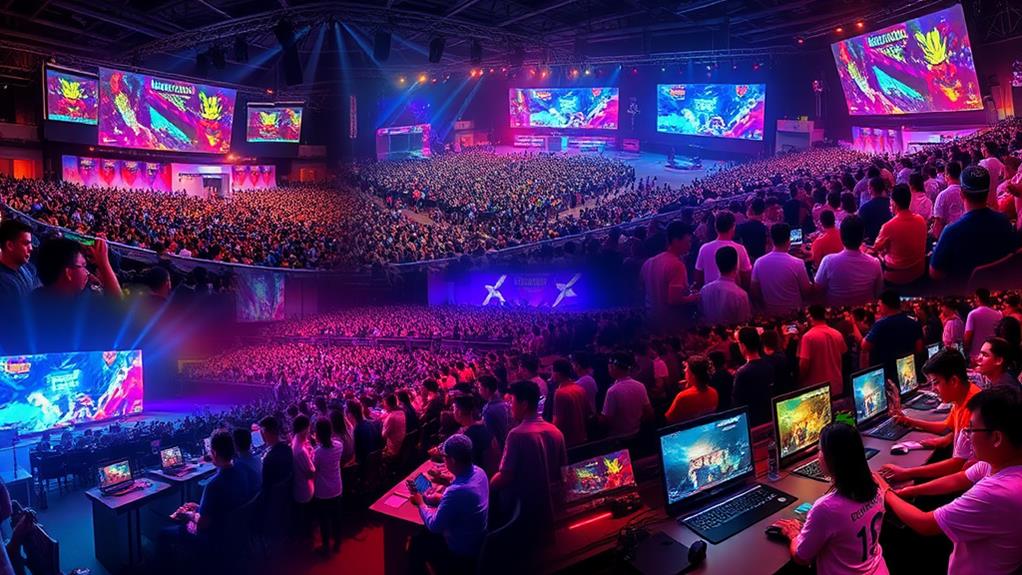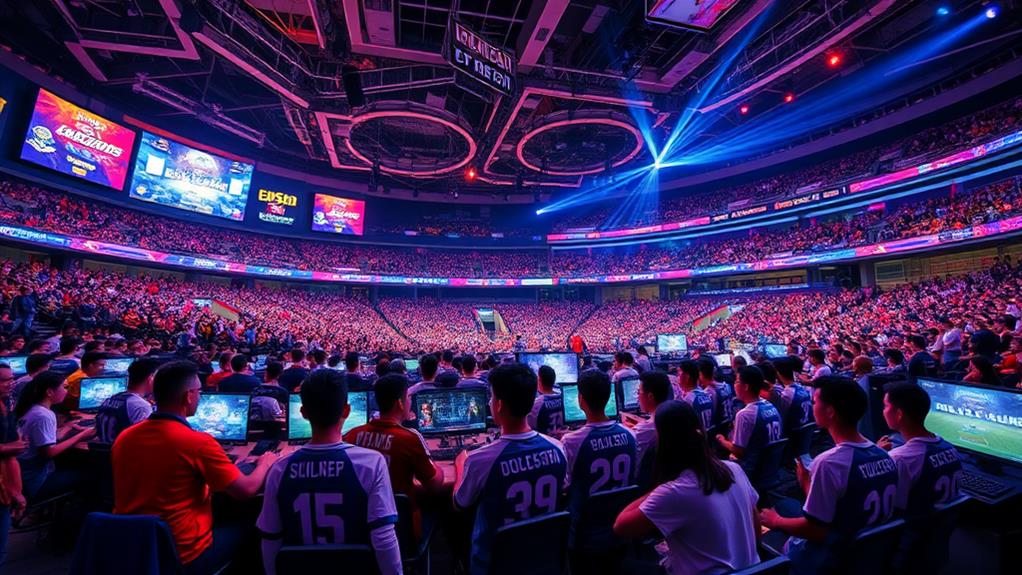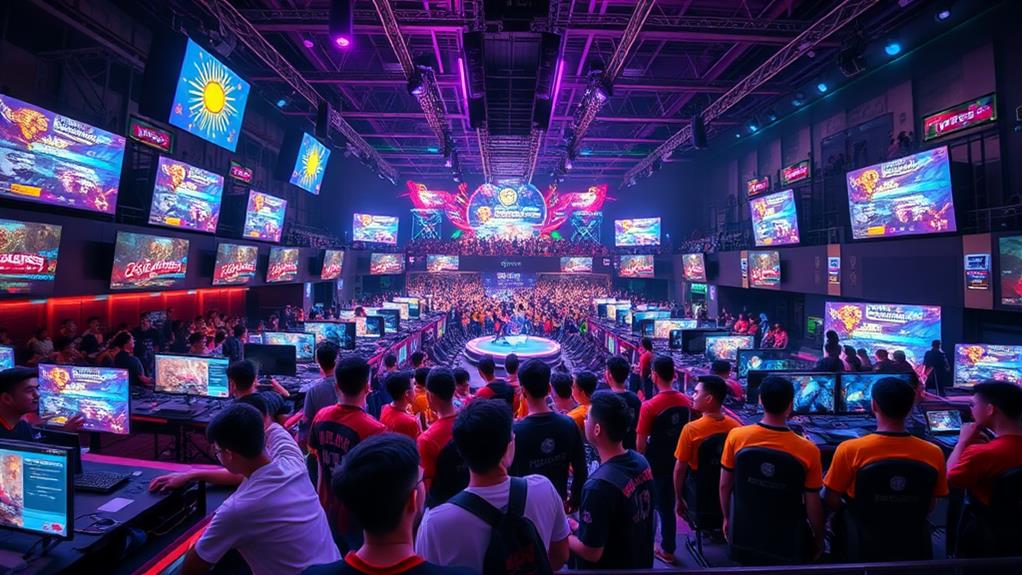E-sports in the Philippines is transforming into a thriving industry. With a massive community of 43 million active gamers, interest and investment are on the rise.
The Mobile Legends Professional League is a prime example of this competitive spirit, showcasing local talent and driving enthusiasm.
Challenges persist, however. The lack of dedicated venues and minimal government support hinder growth.
Despite these obstacles, the future looks promising, particularly in mobile gaming, which is expected to reach $1.5 billion by 2025.
As the landscape continues to expand, understanding the next steps will provide valuable insights into the opportunities that lie ahead.
Historical Growth of Esports

The Early Days of Esports in the Philippines
Esports in the Philippines began to take shape in the early 2000s. During this time, internet cafes transformed into social gaming hubs where competitive gamers connected and honed their skills.
These hubs played a crucial role in laying the groundwork for the country's esports scene.
The Launch of the Mineski Pro-Gaming League
The launch of the Mineski Pro-Gaming League in 2011 marked a significant milestone in the history of esports in the Philippines.
This event established the country's first major esports tournament, attracting thousands of participants and spectators. The league set the stage for future esports events, further solidifying the country's position in the industry.
The Rise of Streaming Platforms
The 2010s saw the rise of streaming platforms such as Twitch and YouTube, which played a crucial role in popularizing esports.
These platforms allowed gamers to watch and engage with gaming content, fostering a dedicated community around competitive gaming.
By providing a platform for gamers to connect and share their experiences, streaming platforms contributed to the growth of esports in the Philippines.
Esports Revenue and International Recognition
By 2020, the Philippine video game market revenue soared to approximately $1.26 billion, reflecting a significant increase in interest and investment in esports.
This growth culminated in international recognition for the national esports team, Sibol, which excelled at the Southeast Asian Games, winning multiple medals and showcasing the depth of talent in the Philippines.
The national esports team's success at the Southeast Asian Games demonstrated the country's potential in the global esports arena.
Current Landscape of Esports
The Philippine esports market is thriving. This is evident in the presence of prominent esports teams like Smart Omega, Nexplay, and Bren Esports, which consistently participate in major esports tournaments.
Competitive events such as the Mobile Legends: Bang Bang Professional League (MPL) and The Nationals attract considerable attention, reflecting the rising popularity of gaming among Filipinos.
Four games dominate the Philippine esports scene: Mobile Legends: Bang Bang, Dota 2, League of Legends, and Valorant.
The free-to-play model of these popular games has significantly lowered entry barriers, allowing more players to engage and compete within the esports ecosystem. This is particularly true for Mobile Legends: Bang Bang, which has become a staple in the Philippine gaming community.
Grassroots development initiatives play a crucial role in player participation and skill cultivation. These initiatives ensure a steady influx of new talent, which contributes to the growth of the industry.
As the infrastructure for competitive gaming continues to improve and developer support remains robust, the revenue of the Filipino esports industry is poised for substantial growth.
The current landscape of esports in the Philippines is a thriving hub for innovation and collaboration, setting a precedent in Southeast Asia. It isn't just about competition, but also about fostering a community that promotes growth and development.
Future Growth Opportunities

The Philippine esports landscape is poised for significant growth, driven by emerging opportunities that can redefine its future.
Mobile gaming expansion will significantly boost the esports industry, with projections indicating a market value of $1.5 billion by 2025. This growth is fueled by the country's youthful population, with 75% of Filipinos under 25, who are driving engagement and participation in competitive gaming. In fact, the industry has already grown at an impressive annual rate of 12.9% since 2017.
To capitalize on these trends, investments in dedicated esports venues are crucial. These venues can meet international standards, attracting major esports events and elevating the Philippines' profile on the global stage. For instance, a dedicated venue can host international tournaments, bringing in revenue streams and exposing local teams to global competition.
Government initiatives are vital in establishing a well-defined esports ecosystem, paving the way for investments and clearer opportunities for players and teams. By providing support, the government can create an environment conducive to growth, enabling the industry to reach its full potential.
The youth engagement in esports is a key driver of growth, ensuring continuous participation and fueling the industry's expansion. As the youth population continues to engage with competitive gaming, the industry will experience sustained growth.
| Growth Opportunities | Impact on Esports Industry |
|---|---|
| Mobile Gaming Expansion | Increase in revenue streams |
| Dedicated Venues | Attraction of international events |
| Government Initiatives | Enhanced investment opportunities |
| Youth Engagement | Continuous growth in participation |
These elements combined can set the stage for a thriving esports future in the Philippines.
How Will E-Sports Contribute to the Future of Sports Technology in the Philippines?
E-sports will play a significant role in shaping future sports technology in the Philippines. As the popularity of e-sports continues to grow, so does the demand for advanced technology such as virtual reality, live streaming, and AI for player analytics. These advancements will undoubtedly impact the future sports technology philippines.
Challenges Facing the Industry
Challenges Facing the Esports Industry in the Philippines
The esports industry in the Philippines faces significant obstacles that hinder its growth and sustainability. The lack of dedicated esports venues is a major issue, affecting the quality of competition and limiting the potential for hosting major events. This shortage also contributes to the underdevelopment of essential infrastructure, which minimal government support fails to address.
The absence of a defined esports ecosystem makes it difficult for players and teams to navigate the competitive landscape and find opportunities. Local esports organizations are vulnerable due to their reliance on sponsorships, which are increasingly being redirected to social media influencers. This shift in sponsorship priorities leaves esports organizations struggling to secure financial backing.
Furthermore, the Filipino esports scene faces stiff competition from successful international teams, which have mastered content creation to diversify their income streams. To remain competitive, the local esports industry must adapt strategically to match these larger entities.
Addressing these challenges is critical for the Filipino esports industry to thrive. Securing better support, developing clearer structures, and finding innovative ways to engage sponsors are essential for enhancing competitiveness and growth.
Prospects and Industry Evolution

The Filipino esports industry is poised for significant growth, driven by its large gamer base and rapid expansion. With over 43 million active gamers and a 12.9% annual growth rate since 2017, the Philippines is on the cusp of a major industry evolution.
Sibol's success in international competitions has boosted national pride and interest in esports, paving the way for further growth.
Investment opportunities are expanding, with the video game market projected to hit $2 billion by 2025. This influx of investment will foster better infrastructure and competitive environments, creating a more conducive ecosystem for esports.
The potential of esports to become a sustainable industry is becoming clearer as more players engage. A growing demand for dedicated venues will help meet international standards, further solidifying the Philippines' position in the global esports scene.
Corporate support is increasing, providing the necessary resources for the industry to thrive.
As these elements converge, the Philippines can cultivate a thriving esports ecosystem that attracts talent and investment, ensuring a bright future for the industry.
Questions and Answers
How Big Is Esports in the Philippines?
The Philippines has a thriving esports scene, with 43 million active gamers. This massive gaming community fuels professional leagues, which in turn attract tournament sponsorships.
For instance, the Philippine Pro Gaming League (PPGL) is a prominent league that has partnered with prominent brands such as Globe Telecom and PLDT.
Streaming platforms play a significant role in enhancing youth engagement. Platforms like Facebook Gaming, YouTube Live, and Twitch provide opportunities for young gamers to connect with their idols, learn new strategies, and participate in online tournaments.
Mobile gaming is extremely popular in the Philippines, driving local competitions. Games like Mobile Legends, PUBG Mobile, and Clash of Clans have become cultural phenomena, with local tournaments and competitions sprouting up across the country.
These competitions offer avenues for player development, allowing aspiring gamers to hone their skills and compete against the best.
The growing esports scene in the Philippines provides international exposure and career opportunities. Filipino gamers can now compete in international tournaments, earning recognition and prizes.
This, in turn, opens up career opportunities for aspiring gamers, including professional gaming, coaching, and streaming.
What Is the Biggest Growing Industry in the Philippines?
The biggest growing industry in the Philippines is the business process outsourcing (BPO) industry.
The BPO industry has experienced rapid growth in recent years, driven by the country's large pool of skilled and English-proficient workers, favorable business environment, and lower labor costs compared to other countries.
In 2020, the BPO industry generated over $28 billion in revenue, accounting for around 7% of the country's GDP. This growth has led to the creation of thousands of jobs, both directly and indirectly, contributing to the country's economic development.
The Philippine government has also been supportive of the industry, providing incentives and infrastructure development to attract more foreign investors. For instance, the Philippine Economic Zone Authority (PEZA) offers tax holidays, exemptions, and other perks to BPO companies operating within special economic zones.
This support has encouraged companies like Accenture, Convergys, and IBM to establish operations in the country.
The growth of the BPO industry has also led to the development of related industries, such as infrastructure and real estate. As the demand for office spaces and housing for BPO workers increases, property developers and construction companies have responded by building new office buildings, residential complexes, and amenities like shopping centers and restaurants.
Is Esports a Fast Growing Industry?
Esports is a rapidly growing industry. This growth is driven by the increasing diversity of players and the rise of mobile esports. For example, the mobile game PUBG Mobile has over 500 million active players worldwide.
Streaming platforms like Twitch and YouTube amplify engagement, allowing fans to watch and interact with their favorite players.
Major brands are taking notice, with companies like Coca-Cola and Nike investing in esports sponsorships.
Tournament structures are becoming more organized, leading to the growth of vibrant gaming communities. The Overwatch League, for instance, features 20 teams from around the world competing in a regular season and playoffs.
Government support is increasing, with countries like South Korea and the United States recognizing esports as an official sport. This support has led to numerous career pathways opening up, including professional players, coaches, and team managers.
What Caused the Rapid Growth of the Esports Industry?
Accessibility to the internet has been a primary driver of the esports industry's rapid growth. The widespread adoption of the internet, especially among young people, has enabled the growth of a thriving gaming culture.
Streaming platforms like Twitch have elevated engagement by providing a space for gamers to share their experiences, connect with others, and learn from professional players.
Competitive tournaments, such as the League of Legends World Championship and The International, draw in large audiences and attract new participants to the esports scene.
Sponsorship deals have boosted financial support for esports teams and events, allowing them to invest in infrastructure, talent, and marketing.
The rise of mobile gaming has lowered barriers to entry, making it easier for people to start playing games and participating in esports.
Community involvement has fostered local talent, which is influenced by global trends and technological advancements.
This has created a vibrant ecosystem that propels the industry forward, with local and international events drawing in large crowds and generating significant revenue.